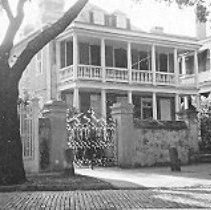Archive Record
| Object Type | Property File |
| Title | 39 Church Street (George Eveleigh House) |
| Scope & Content |
Constructed 1743; renovated and restored early-20th century. Although this house is set back from the street and has an asymmetrically placed front door leading onto a front piazza, it originally had a center door leading to the larger of two front rooms. Front and rear piazzas appear on the 1795 plat of the property, usually indicating a feature added after the Revolution. Nonetheless, an account of the hurricane of 1752 refers to the destruction of brick columns on the front of the building and closers in the central aperture of the 2nd floor brickwork confirm the presence of a early piazza. The Eveleigh House is of the same floor plan as the Thomas Rose House at 59 Church Street, built 8 years earlier, if slightly smaller in scale. As in the Rose House, much of the original paneling remains, with similar arched cupboards or bowfats in the 2nd floor drawing room. Most of the original mantels were removed long ago. In the early-20th century mantels from the demolished Nathaniel Heyward House on East Bay were installed in the principal room and the 2 rear rooms on the 1st floor were combined to create a dining room. Of particular interest on the exterior are the brickwork and window openings with segmental arched heads. George Eveleigh was a prosperous deerskin trader in Charles Town when he purchased a lot lying across Vanderhorst Creek just outside the former city wall line. The creek was filled and is known today as Water Street, and with this filling Church Street was extended to White Point. Eveleigh sold the property about ten years later to John Bull, a wealthy planter in Prince William Parish. The Bull family later subdivided the rear of the lot facing Meeting Street, where they subsequently constructed 34 Meeting Street. A later purchaser of 39 Church Street was the 18th-century chemist and naturalist Jean Louis Polony, a Santo Domingan refugee. (Poston, Buildings of Charleston.) Files contain documentation of the easement on the property including copy of original easement document and deed, appraisal, and related correspondence; Part I certification (National Register); annual inspection reports, requests for alterations, and correspondence related to the management of the property; research report (Eberle 2017); FOHG house history (2000); other narrative histories including building history from Architectural Guide to Charleston (by Simons & Thomas), Vernacular Architecture of Charleston and the Lowcountry, and Information for Guides of Historic Charleston; entry from 60 Famous Houses; newspaper articles (including DYKYC); historical/chain-of-title research information (through 1875); drawing "East and West Facades Evolution: Conjectural Timeline" by Richard Marks Restoration (11/3/2010); plat (2009). See Easement Documentation Photo Files for easement donation photographs (Exh. B to Deed of Conservation Easement) and Covenant/Easement Inspection Photo Files for inspection photography. File also contains HCF summer intern research on the outbuildings and the enslaved persons in preparation for HCF's "Beyond the Big House Tour" (2017) and tour notes. |
| Subjects |
Historic buildings--South Carolina--Charleston Historic gardens--South Carolina--Charleston Outbuildings--South Carolina--Charleston |
| Search Terms |
Church Street Easement Property Loutrel Briggs garden |
| Physical Description |
1 Gift Folder 1 Management Folder 1 History/Miscellaneous Folder |
| Related Records | Show Related Records... |
| Object ID # | CHURCH.039.1 |





